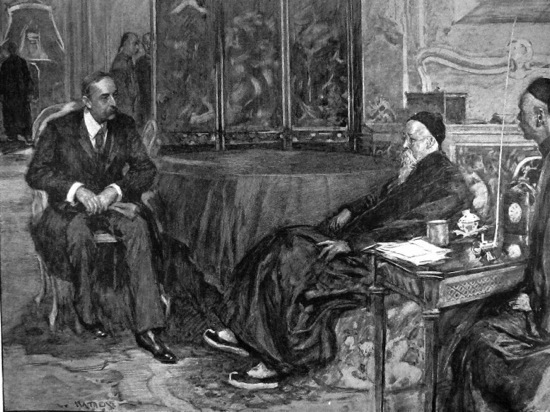A Chinese Cultural Revolution

Something I neglected to mention earlier in the week is that while Chinese nationals were pouring into America by the tens of thousands through the West, a small but steady stream was coming in via the port of New York. By the 1870’s a Chinese community had established itself on the Lower East Side of Manhattan in the vicinity of Mott street. There they set up a variety of import shops supplemented by — you saw it coming — restaurants.
Food geared to both Chinese immigrants and curious non-Chinese New Yorkers was served in these establishments. Young artistic/Bohemian types were especially drawn to Mott Street, both for the novelty and the value. Popular among these hipsters was a dirt-cheap stir fry of kitchen leftovers — mostly vegetables with some chicken or duck giblets thrown in — that went by the name of “shap sui.” It wasn’t unique to New York. Indeed it was a very ordinary sort of Chinese hash (“shap” = mixed together, “sui” = little bits) common in villages in the Peal River Delta. American Chinese restaurants around the country served it with no more regard than a modern hamburger stand would serve up an order of fries.
Then something unexpected happened. In early 1896 the Chinese Viceroy and ambassador, a fellow by the name of Li Hung Chang visited the US. His arrival was accompanied by no small amount of hooplah as tensions with China were high at the time. After disembarking in Lower Manhattan, the elderly Li was escorted amid great fanfare to the Waldorf Astoria Hotel. His every action was observed and noted by the press.
One evening a banquet was held in Li’s honor. A selection of French delicacies were laid out before him, all of which he either rejected or scarcely tasted. The only thing he ate “with relish”, or so it was later reported, was a plate of “chow chop sui.”
It probably never happened (a member of the Chinese aristocracy eating Pearl River Delta peasant food?). Yet with this single and most likely apocryphal act, Li not only legitimized American Chinese food, he instigated a “chop suey” feeding frenzy that would endure for decades.
He would also spin off more than a few urban legends. The most often repeated of these involves Li’s cooks who, frustrated by the rich and decadent dishes being served to their master, invented and named chop suey in the Waldorf Astoria’s kitchens. A similar one holds that Li himself invented it as a symbolic gesture, a blend of Eastern and Western traditions. Another story involves Li escorting visiting statesmen to New York’s Chinatown where the dish was already being served. There are dozens of variations.
And of course they only supplement a longstanding heap of other chop suey origin myths, each of which has its own unique cast of characters: drunken miners, ambitious young Chinese dishwashers, raucous railroad workmen and racist white diners shouting “chopped sewage!” There’s a lot of fun to be had if you have a little to waste on some google searches.
For indeed the truth, at least as reported by the Washington Post, is extremely mundane: a Chinese dignitary, unimpressed with the local food, is offered a simple Chinese meal instead. Exactly what it is is unknown, but is reported as “chop suey”, a dish most Americans at the time had at least heard about even if they’d never tried it. The result is that almost every American within reach of a Chinese restaurant is soon demanding to try a little of what Li Hong Chang ate — and feeling mighty proud and adventurous for having done so.
fascinating stuff, Joe 🙂 I always learn a ton coming here!
Thanks Ann! I’ll do my best to keep it up!
– Joe
You have a fantastic site ! I was wondering if you have ever seen what I call Chinese puff pastry being made ? it is the coolest way i’ve ever seen to make a laminate dough. I was looking for baked mooncake ideas along with baked dim sum ideas and chanced upon this video.I was stunned when I first saw it. A warning, the music is a little loudish.http://www.youtube.com/watch?v=ig7UV_Idw78&feature=related
Thanks very much Stuart — and thanks for the video. An “oil dough” eh? Very interesting…a clever substitute for butter indeed. For of course peoples of East Asia have long been know for their disdain of butter. I wrote about that in one of my own personal favorite posts here:
http://joepastry.com/2008/triumph_of_the_butter_stinkers_1/
Thanks again Stuart!
– J